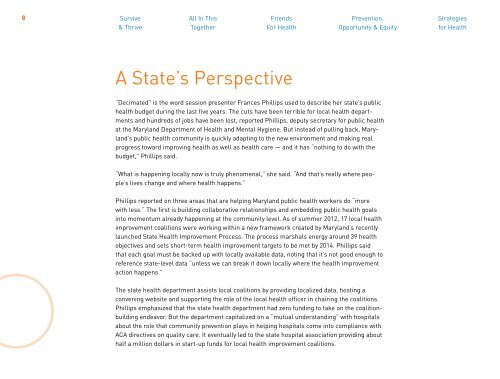INSIGHT & INSPIRATION FROM APHA’S 2012 MIDYEAR MEETING
INSIGHT & INSPIRATION FROM APHA’S 2012 MIDYEAR MEETING
INSIGHT & INSPIRATION FROM APHA’S 2012 MIDYEAR MEETING
You also want an ePaper? Increase the reach of your titles
YUMPU automatically turns print PDFs into web optimized ePapers that Google loves.
8<br />
Survive All In This Friends Prevention, Strategies<br />
& Thrive Together For Health Opportunity & Equity for Health<br />
A State’s Perspective<br />
“Decimated” is the word session presenter Frances Phillips used to describe her state’s public<br />
health budget during the last five years. The cuts have been terrible for local health departments<br />
and hundreds of jobs have been lost, reported Phillips, deputy secretary for public health<br />
at the Maryland Department of Health and Mental Hygiene. But instead of pulling back, Maryland’s<br />
public health community is quickly adapting to the new environment and making real<br />
progress toward improving health as well as health care — and it has “nothing to do with the<br />
budget,” Phillips said.<br />
“What is happening locally now is truly phenomenal,” she said. “And that’s really where people’s<br />
lives change and where health happens.”<br />
Phillips reported on three areas that are helping Maryland public health workers do “more<br />
with less.” The first is building collaborative relationships and embedding public health goals<br />
into momentum already happening at the community level. As of summer <strong>2012</strong>, 17 local health<br />
improvement coalitions were working within a new framework created by Maryland’s recently<br />
launched State Health Improvement Process. The process marshals energy around 39 health<br />
objectives and sets short-term health improvement targets to be met by 2014. Phillips said<br />
that each goal must be backed up with locally available data, noting that it’s not good enough to<br />
reference state-level data “unless we can break it down locally where the health improvement<br />
action happens.”<br />
The state health department assists local coalitions by providing localized data, hosting a<br />
convening website and supporting the role of the local health officer in chairing the coalitions.<br />
Phillips emphasized that the state health department had zero funding to take on the coalitionbuilding<br />
endeavor. But the department capitalized on a “mutual understanding” with hospitals<br />
about the role that community prevention plays in helping hospitals come into compliance with<br />
ACA directives on quality care. It eventually led to the state hospital association providing about<br />
half a million dollars in start-up funds for local health improvement coalitions.



